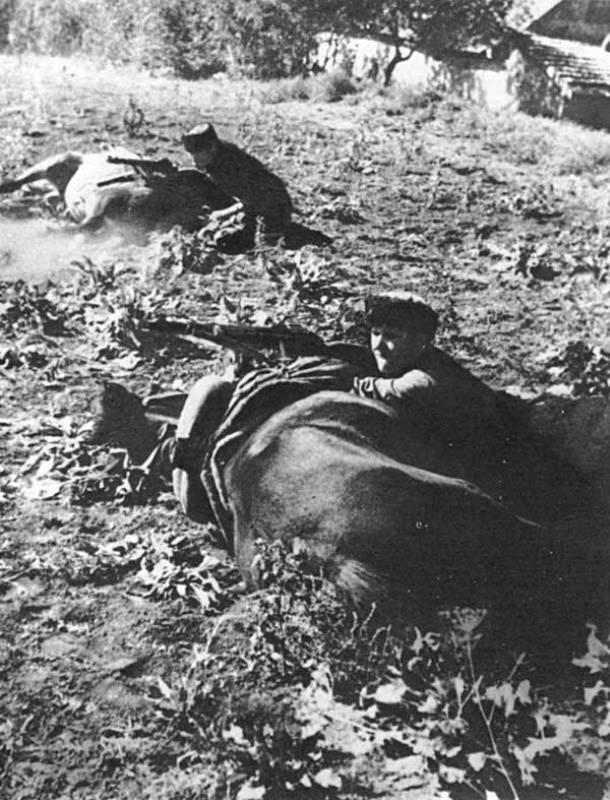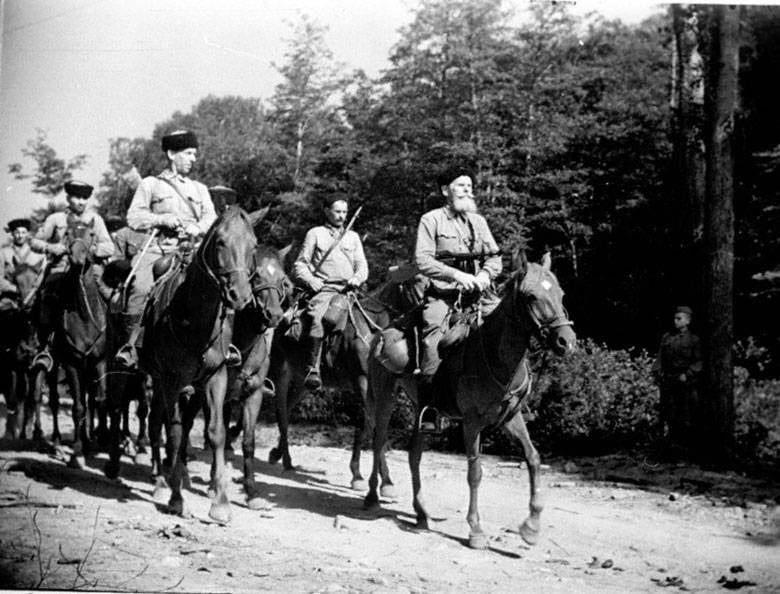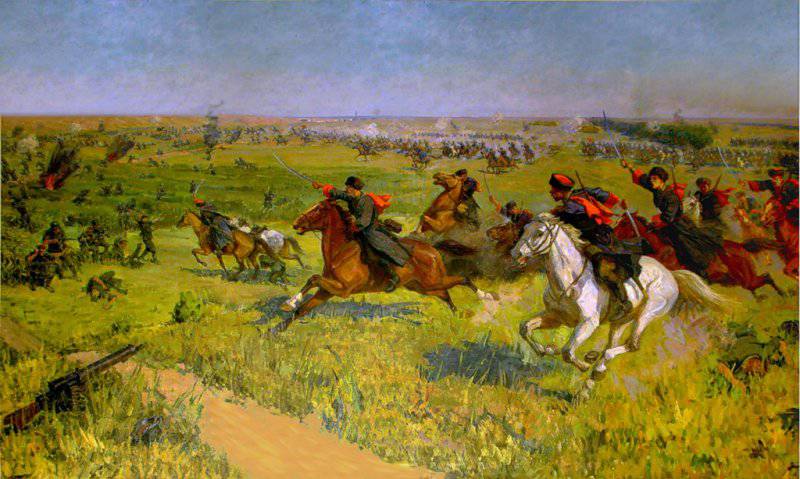Fight at the village of Kushchevskaya
Let's start with the fact that it was not only a tactical victory - the stubborn resistance of the Soviet troops in this direction was extremely necessary to achieve one important strategic factor. Just these days, intensive work was carried out on the Maykop oil fields to destroy them. The personal order of the Supreme Commander allotted only five days to this operation, and the Kuschevskaya attack, like other defensive battles in the neighboring villages, made it possible to gain time to execute the order.
This battle had another important consequence, which, unfortunately, is rarely remembered now: a sobering effect on the Nazis, who pinned too bright hopes on the Russian Cossacks. Official propaganda promised them that the Cossacks would greet the liberators with flowers and with joy, in large numbers would turn their weapon against the Bolsheviks. It is known that in the initial period of the war the Germans managed to attract to their side a fairly large number of Cossacks who sold themselves for promises to create an independent Cossack state and ideas of revenge for the lost civil war. German newspapers and newsreels of that time constantly told about the exploits of the Cossack units and units of the Wehrmacht. And although the Germans met with the Cossacks of the Red Army more than once, it was the Kuschev attack that produced an extremely powerful psychological effect and gave rise to many rumors and legends on both sides of the front. That is why it is so difficult to find references to it in German sources, which is why modern spiritual heirs of Dr. Goebbels so diligently underestimate the significance and scope of this glorious page of Russian military history and Cossack history.
The overall picture of the situation on this sector of the front looked approximately as follows. Having occupied 23 July 1942 Rostov-on-Don, the troops of the Wehrmacht 17 th army developed an offensive to the south of the Kuban. The troops of the North Caucasus Front were tasked with detaining the enemy by any means and restoring the position along the southern bank of the Don.
July 30 The 91 th Infantry Regiment and units of the 4 th Mountain Division of the Wehrmacht Entsian (Enzian), went to the river Eya west of the village of Kushchevskaya. These lines held the 18 Army units under the command of Lieutenant-General Fedor Vasilyevich Kamkov. Several attacks were undertaken, repulsed by Soviet troops, but mountain riflemen managed to capture bridgeheads threatening from the flanks of the 216 Infantry Division, which held the village.
The next day, the stubborn fighting in Kushchevskaya continued: the Germans attacked several times, and the position of the Soviet troops deteriorated. On the morning of July 31, the German infantry, when fighting was already in the very village, the situation became threatening throughout the front, along the middle course of the river Ye. The Germans developed the offensive on the positions of the 12 of the Kuban and 116 of the Don Cavalry Divisions defending the neighboring villages of Shkurinskaya and Kanelovskaya.
The Cossacks there counterattacked several times and even managed to throw the enemy off for a while, but he had too much superiority in reserves and air support. As a result, by the end of July 31, the last units of the 216 Infantry Division of the 18 Army left Kushchevskaya.
At nightfall, the Cossacks of the 15 Don Cavalry Division, which was part of the 17 of the Kuban Cossack Corps, approached the village. They tried to dislodge the enemy from the village, but the attack was unsuccessful.
The situation that had been created was extremely unprofitable for the retreating Soviet troops, who were sorely lacking time to organize a solid echelon defense. The village of Kushchevskaya was a very convenient base for the development of the German offensive, it posed a threat to the Soviet troops retreating on the Tuapse and Mozdok axes.
In order to restore positions on the Eya 1 on August, the command of the North Caucasus Front decided to bring in a fresh 13 Cavalry division, also part of the 17 of the Kuban Cossack Corps.
Such is the general background of the battle. But before proceeding to it, it should be said that the 17 body was a rather unusual connection. In addition to the fact that it was formed from Cossacks and the Cossacks themselves at their own expense, residents of the Cossack villages of Don and Kuban recorded as volunteers. Many of them were of irrevocable age, but they had the experience of the First World, Civil and other wars. They were fired professional warriors, knowing the price of life and death, able to weigh the risk, who understood what they were going to. And for what. Such a body could well be called elite.
Another, and also very important, advantage in the upcoming battle was the nature of the terrain: most of the territory adjacent to the river from the south and east to the river Ee was covered with groves and gardens, cut by numerous beams, which favored the covert concentration of large cavalry forces. At the same time, the neighborhood of Kushchevskaya itself was more open and a significant part of the German positions was quite clearly visible.
The 13-I Kuban Cossack Cavalry Division consisted of three cavalry regiments and an artillery division. Cossack squadrons, using high maize, sunflowers, and forest belts, with a green wall that approached Kushchevskaya, secretly occupied the original position a half to two kilometers from the village on the night from 1 to 2 in August.

In the morning the Cossack regiments were ready to attack. It was decided not to carry out artillery training - the bet was placed on the surprise of a massive saber strike.
Marshal Andrei Antonovich Grechko mentioned in his memoirs that at dawn Kushchevskaya was bombed by the Soviet aviation - Perhaps this also influenced the decision to act without artillery preparation.
Unfortunately, in all the memories, especially those directly involved in the battle, there are many discrepancies and contradictions. For example, the exact time of the attack is unknown. Most sources claim that it began at dawn, but still more likely - closer to noon, since in the morning additional German motorized infantry units managed to enter the village. This fact, possibly, is connected with numerous testimonies of the destroyed German tanks... German sources do not mention any tank units operating in the area. Therefore, it is most likely that the Cossacks mistook armored personnel carriers or several self-propelled assault guns attached to reinforce the 4th Mountain Rifle Division for tanks. However, the participation of German tanks cannot be completely ruled out.
Half of the distance to the enemy (about a kilometer), the Cossacks walked in steps, seeping through the forest belts, stretching almost parallel to the line of attack. Then they went over to a lynx, and with four hundred horsemen, meters, gleaming blades and shouting "Hurray!" Went into a gallop. They were met by late gunfire and mortar fire, machine-gun and machine-gun fire, but nothing could stop the Cossack lava. A few more minutes ... and a deadly hurricane struck the fascists!
The success of the attack contributed to the suddenness. It should also be noted that the presence of automatic weapons and machine guns in itself does not mean the possibility of stopping a massive cavalry attack. To do this, first of all, the correct location of the machine-gun points (from the flanks and at a certain distance) is necessary. Apparently, the Germans did not expect a strike in the afternoon in the equestrian system, this was a rather rare tactical device.
After all, tactically cavalry in World War II was closest to the motorized infantry units and formations. The combat operations of motorized infantry and cavalry were very similar. In the first case, before the battle, the infantrymen landed from armored personnel carriers or trucks, the drivers drove the vehicles into shelters. In the second case, cavalrymen dismounted, and horse breeders would withdraw horses. The combat regulations of the cavalry envisaged an attack in the equestrian system only as an exception, under particularly favorable conditions. The Kushchevskaya attack turned out to be just such an exception: a deceived and demoralized enemy, caught off guard, could not meet the Cossacks with strong fire and put up organized resistance.
But back to the battle.
Panic at the enemy was terrible, according to the most modest and careful calculations, in the first attack the Cossacks hacked more than one and a half thousand German soldiers and officers, and about three hundred were captured. Cossack lava scattered through the streets, pursuing scattered groups and single Germans. This slowdown gave a respite and allowed to organize a counterattack to the motorized infantry, which took up positions at heights stretching from Kushchevskaya to the Vesely farm. Soon German planes appeared. But the fascist troops failed to seize the initiative that day. The armored vehicles were met by direct fire from the artillery division, which had by then taken up positions in front of the village. But the Germans did not wait for air support - in conditions of close contact with the enemy it was impossible and the planes flew back.

After clearing the streets, the Cossacks again went on the attack, they approached close to the armored vehicles and at a gallop threw cars with grenades and incendiary bottles.
Cossack squadrons rushed through the gaps and burning houses, sowing terror and putting the infantry to flight. The battle fell apart into separate fights - from behind the river and from the farm of Bolshaya Lopatin, new divisions of the Germans arrived, but they entered the battle in an inconsistent manner, in small groups. And only a numerical superiority and suitable reinforcements from various sides allowed them to continue the struggle.
In the Soviet sources and memories of the participants in this battle, the elite mountain division Edelweiss is almost universally mentioned. In fact, in Kuschevskaya there was a similar, and also mountain rifle, Entsian. But separate units of Edelweiss could (and even should) come to the aid of their units in the afternoon. In any case, the modern German author Wilhelm Ticke, based on the staff documents, asserts that in addition to the 4 units of the Mountain Division, as well as the 73 and 125 Infantry Divisions of the Wehrmacht 2 of August, in the area of Kushchevskaya there were divisions of the 1 Mountain Division, "Edelweiss".
This is just one example of how due to the careful efforts of the Germans to exclude any mention of the victory of the Cossacks and numerous exaggerations in our sources, it is very difficult for modern historians to restore a detailed picture of the battle.
In general, the loss of the Germans for the whole day of the battle in Kushchevskaya can be assessed within fairly wide limits: from three to five thousand people and about a hundred guns and mortars. As for tanks, if there were any, and other armored vehicles, this is a question that researchers still have to answer.
But the Soviet tanks were: after about an hour and a half, units of a separate Maikop tank brigade formed from cadets of the Oryol tank school and received an order to clear the village of Kushchevskaya, interacting with parts of the 13 Cavalry Division, entered the battle.
By the time tanks appeared, the Germans had almost ousted Cossacks from the stanitsa, most of whom dismounted — they had to cling to any shelter. Control of the division as a whole was lost, the squadron commanders acted independently, and the Germans had practically overcome the panic. Therefore, we can say that our tanks appeared on time, and they decided the outcome of the battle. They attacked the village several times within an hour and a half. At the same time, another counterattack was successfully repulsed: the Germans tried, using the same forest belt, to go to the rear of the Soviet troops, but (perhaps by accident) went straight to the Russian tanks.
By the end of the day, the village of Kushchevskaya was finally completely cleared of the enemy.
The losses of the Soviet troops in the 2 battles of August under Kuschevskaya turned out to be significantly less than that of the Germans - about a thousand people, three T-34 tanks and four BT-7.
And at the end of this story we will quote from the diary of a murdered German officer, found on the next day 3 of August near the village of Shkurinskaya - there the squadrons of the 12-th Kuban division also went on the attack in the equestrian ranks: "... we were faced with some Cossacks. These are devils, not soldiers. And they have steel horses. You can't get out of here alive ... "
In 1967, a monument was erected on the outskirts of the village of Kushchevskaya - a rider on a rearing horse, with the inscription: "Here in August 1942 stood dead, defending the gates of the Caucasus, 4 Guards Kuban Cossack Corps, surprising the world with his resilience and greatness of spirit."
In 2008, a memorial complex "Field of Cossack Glory" was built at the scene of the battle.

Information